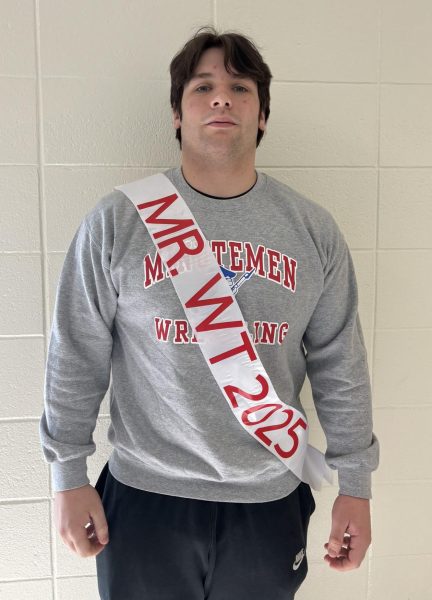WTHS teachers prepare for new challenges in 2020 school year
In English and Journalism teacher Mrs. Pierson’s classroom, socially-distanced desks take the place of flexible seating and tables.
On Tuesday, September 8th, WTHS staff and students “returned” to school for full remote instruction to start the 2020-2021 school year. Teachers and other staff members worked tirelessly in the preceding weeks to prepare for this unique situation.
For most teachers, the biggest challenge in preparing for the new school year was the uncertainty.
“This year is unprecedented,” mathematics teacher Denise Eckley shares, “the biggest challenge was not knowing exactly how and what the school year was going to look like.”
In addition to the cloud of uncertainty, a significant challenge teachers face is being able to connect with their students – live or remotely.
German teacher Jill Graham worries about not being fully able to interact with her students this year. Graham is also extremely disappointed that she cannot give her students “a big hug when they return to school.” And for French teacher Kathy Hudak, she finds it difficult to find the best tools for her students to use without feedback and experimenting that can be done daily in the live-class setting.
Alongside the large cloud of uncertainty comes technology itself as a challenge, a change, and a concern.
“Nearly everything will be digital,” English teacher Kevin Parker says. This is a significant change from what most people have grown up with: a slow and easy transition to everything being digital, with paper always there as a back-up.
After teaching for thirty years at WTHS, English and theater teacher Abigail Molotksy has found technology a big change and a bit of a challenge. Molotsky (who favors paper and pencil over digital platforms) and other teachers have switched to Schoology. There, Molotsky found it challenging to organize through Schoology and effectively teach from Schoology. Molotsky is forced to be extremely specific with online directions rather than what she is accustomed to: passing out a paper and giving verbal directions.
Technology and technological education are not completely foreign, thanks to the staff members in the technology department within the district and to teachers like business education teacher, Sara Simpson. Simpson has “broadened [her] network of educators” by joining online groups for global education, business education, and Schoology. She has also created groups in Schoology to share resources with other educators in other schools and states while also doing her best to lend a helping hand to her co-workers in need.
Yet, despite these resources, efforts, and aid, Richard Zambino, a history teacher at WTHS, is deeply concerned about executing his classes day by day with technology.
“We can’t always be absolutely a hundred percent sure of what technology is going to throw at us from day to day,” Zambino explains.
Sharing some of Zambino’s concerns, Molotksy worries about the students without decent WiFi and is slightly concerned about students not showing themselves on camera.
“I’m okay with [students not being on camera] but how do I know if they’re not understanding,” Molotsky shares, “there is a lot that I can see through body language and on their faces.”
In addition to technology concerns, teachers like Graham and Joseph Zachowski, a choir teacher at WTHS, share the same concerns of physical and mental health as well as safety of each individual at the school.
“I believe our district has developed solid procedures,” Zachowski states optimistically, “but it takes a village to make sure we all follow them to keep our schools open.”
Along with these challenges and concerns, some of the biggest changes have occurred in the classroom environment and within the curriculum. Most departments have modified the curriculum to adapt to the hybrid schedule or shifted their approach to accomplish their courses.
For example, in physical education (PE) classes, there haven’t been any significant changes to the curriculum, but in person exercises consist of walking, running, and mindfulness exercises, Jeffrey Rearick, a PE teacher, explains. Rearick further describes that online or remote students will be completing workouts in their own time and submitting a weekly log for grading purposes, something that was implemented back in March when the school went fully remote for the end of the 2019-2020 school year.
Similarly, English and world language courses have adapted to the circumstances by reordering reading materials, teaching excerpts of larger works, and shifting their methods in teaching. As an English teacher, Parker is looking to subdivide his class into four readings groups to tackle the task of group discussions. He is hoping to implement discussion boards and video conferencing within the reading groups instead of the entire class, something that he did during the school shutdown back in March.
“I’ve always wanted to try them,” Parker says referencing the reading groups, “but I couldn’t really find a way until now.”
World language teachers have also added “social emotional learning” which gears students to have the skills to face the challenges of an unusual school year and provides a place for students to talk to the teachers (or at least someone) about their fears and concerns. Although this piece to the curriculum was something the world language teachers had already been doing, Graham shares that it’s important the students are able to share “their joy, their worries, ask their questions, and feel cared for in any classroom setting.”
In addition to their “social emotional learning,” world language teachers have to face the challenge of pronunciation, without the ability to meet face to face consistently. Hudak is planning on relying on Quizlet for its feature that allows students to click on the word to hear how it is pronounced. She also plans to utilize Edpuzzle so that students can hear authentic French speakers speak French. Like Hudak, Graham shares the same plans to use Edpuzzle to give students a chance to hear the correct pronunciations along with adding screencasts that contain the rules for pronunciation. Both Graham and Hudak are enthusiastic about using live meetings so that their students can talk, practice, and listen for improvement.
One of the biggest changes to the classroom environment appears in the performing art electives. Choir teacher Joseph Zachowski has revealed that the TWP Choir will be meeting in the 11/12 Auditorium over B11, their smaller classroom, to accommodate social distancing regulations. Zachowski has plans to sing and play during class with specific mitigation strategies: wearing masks, staying socially distant, going outside when possible, and keeping rehearsals to thirty minutes or less.
Zachowski and the other performing arts courses have made their biggest adjustments in performances. For the time, these performances are expected to be mostly virtual, but Zachowski has high hopes for restrictions to be lifted just enough for students to perform live for their parents and community.
As part of the performing arts, Molotsky is eager to share her plans for the fall play – a monologue play that can be streamed online with opportunities for thirty students. Each student will be doing a different monologue with rehearsals online, on the stage in Quay Way, or even in front of the school.
Despite these fast changes, stressful challenges, and significant concerns, it is clear that the teachers are excited to meet their new students and are dedicated to helping them be successful this school year.






